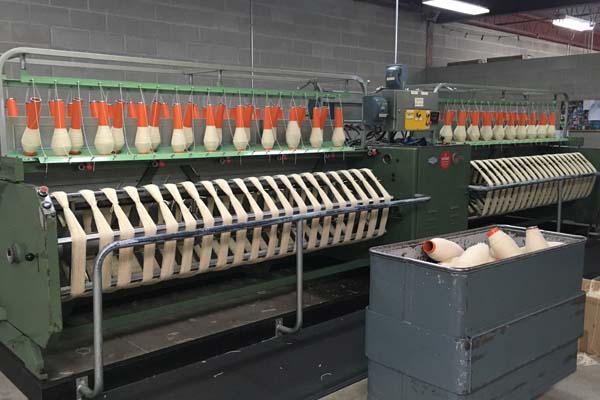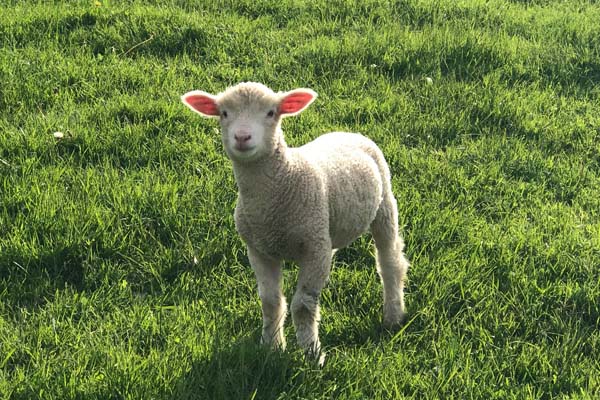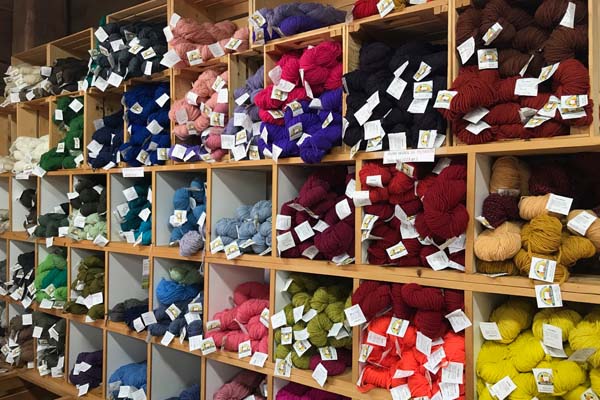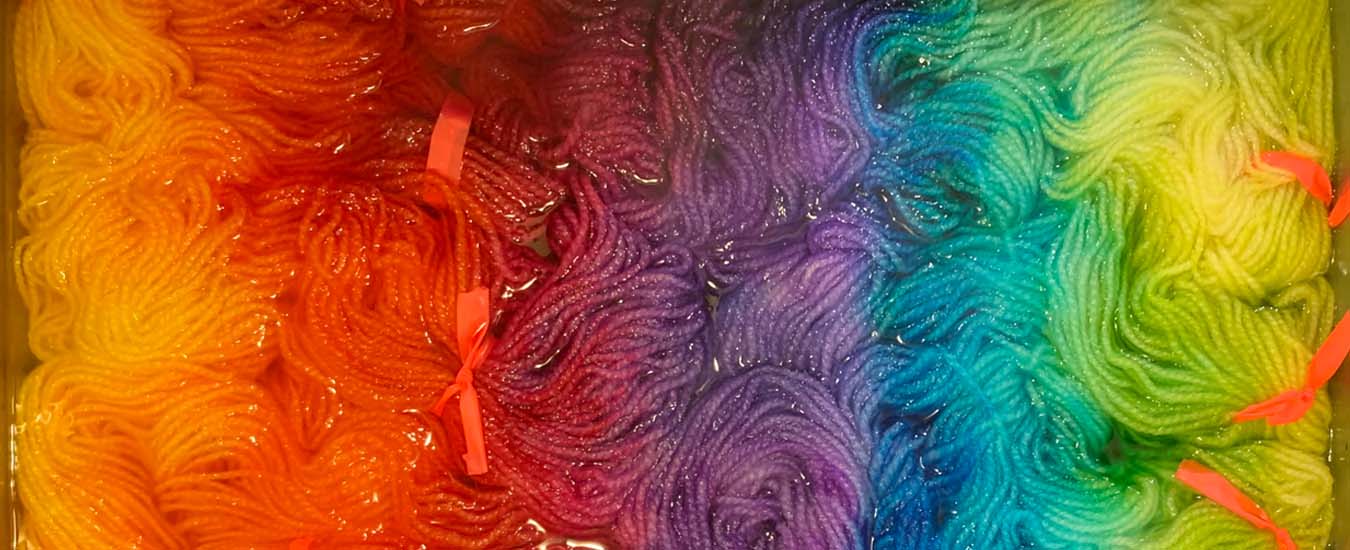The surge in fibre art popularity has meant a growing demand for natural yarns like wool—local wool
Fibre addicts understand the joy of great yarns. We’re so fortunate to have superb local yarn shops, festivals and workshops (in a normal year), and terrific yarns produced right here.
Some are smaller-batch, artisan type yarns, such as those created by Sisterhood Fibres in Tatamagouche and Gaspereau Valley Fibres in Gaspereau, NS; Lichen and Lace in Sackville, NB and Foggy Rock Fibres in Cupids, NL. Others are large operations that have been in operation for generations, and some fall in-between. Here’s just a sampling to whet your appetite for more yarn. (Incidentally, we fibre addicts never disclose the size of our yarn stash.)

Dyeing yarn at Foggy Rock Fibres. Photo by Steve Smith, VisionFire
The finest blankets and more
Dale MacAusland chuckles when I call to ask about ordering a blanket. “I’ll tell you what I have on hand now, and if they aren’t what you want, we can put you on the waiting list. It’ll be likely two months before we can get to yours,” he tells me.
2020 was an “unprecedented” year for MacAusland’s Woollen Mills, located in Bloomfield, western PEI. Dale is the fifth generation of MacAuslands to run the mill since it opened somewhere between 1868-1870. Since 1932, the family business has been making 100 per cent virgin wool blankets, using fibre sourced right here—the only mill in Atlantic Canada making such blankets. They also create yarn, either in natural colours or in more than 36 dyed shades, for fibre enthusiasts across the region.
Dale and his team of employees—including his daughter Monica— usually produce between 40 and 80 blankets a day. The mill features a variety of machinery to wash, card, spin and produce yarn from the wool they purchase. If it’s going to become yarn, it’s wound in four-ounce skeins, and if it’s part of a blanket, some 1,600 threads will be warped onto looms to create the various bedding sizes.
Dale wasn’t sure what 2020 was going to hold for the company when COVID-19 hit last year. “Some orders got cancelled in the spring, and we’re not offering tours now, just curbside pickup,” he says. In July, after they had built up a “nice stock of inventory” it suddenly got very busy with orders, and by early November, they were already past the usual number of sales for the holiday season. “This was the year everyone wanted to support local, and we hope that continues,” he says. “People can’t come in and touch the blankets and wool at present, but they’ve heard about us, or have seen our blankets at other businesses, and they know the pride we take in our work.”

Virgin wool blankets at MacAusland’s
Older than the country
Briggs & Little Woolen Mills near Harvey Station, NB has the distinction of being the oldest continuously operating mill in Canada—since 1857—and five generations of the Little family have been involved with its operation.
Some of the wool they use comes from local farmers but because of the amount required, the majority comes from the Canadian Cooperative Wool Growers in Ontario. Leah Little, office manager, says that the preferable breeds for their purposes are Suffolk, Dorset and Corriedale.
Water from a nearby tranquil pond is used to wash the wool when it arrives, and then it’s put through a series of vintage machinery to be spun into yarn. The mill makes 2,500 4-oz skeins of yarn every day, in a variety of weights and a rainbow of colours—using environmentally friendly dyes—in 2020, they produced 115,858 pounds of yarn in 179.5 days. Along with their own colourways, they create custom colours for some shops like Becky’s Knit & Yarn in Lockeport or Cast On! Cast Off! in St. John’s. Other customers like to dye their own.
Leah Little says they shut down the mill annually for the months of June-August for annual maintenance on the machines—it’s too hot to work with wool in the summer! —while the office and outlet store are open year-round.
The most popular yarn is Heritage worsted weight—especially beloved by knitters of Newfoundland patterned socks, hats, and mittens made famously popular by the three Saltwater Mittens books, written by Christine LeGrow and Shirley Ann Scott, and published by Boulder Books in NL.

Yarn being wound into skeins one of the antique but still very functional machines at Briggs & Little
From fleece to fibre and more
Walking into the yarn shop at Lismore Sheep Farm, not far from Tatamagouche, NS, is one of my favourite treats when I’m on a road trip to the North Shore. Gillian Crawford has it all, literally—sheepskins; products made from those sheepskins like mittens, slippers and hot water bottle covers; yarns processed by both Briggs and Little and MacAusland’s; using her wool; plus other yarns created by independent yarn producers Fleece Artist and Mineville Wool Project from Mineville, NS.
Gillian and her husband John raise about 200 Dorset-cross ewes on their farm. They send the fleeces to Briggs and Little to be made into yarn, and to MacAusland’s to be made into blankets. They also order yarn from the latter, so they have an excellent range of colours from both mills. Gillian likes to have a range of products for all yarn enthusiasts. Additionally, John makes beautiful birch wood knitting needles, popular with anyone who has arthritic hands.
Like other businesses, Lismore has been affected by COVID-19; Gillian stopped attending farmers markets and craft shows, and instead offered free or reduced-rate shipping on her website. She observes, “ordering yarn online isn’t the same as picking it up, touching it, smelling it…” yet customers have been very faithful in supporting local.


A spring lamb at Lismore. Some of the rainbow of Briggs & Little and MacAusland yarns carried at Lismore Sheep Farm.
An independent dyer
Anne Lucas’s delightfully named business, Foggy Rock Fibres, is based at her home in Cupids, NL, about an hour from St. John’s. Anne’s love of fibre goes back to the 1980s, when she saw an alpaca at a fair on Vancouver Island and thought she’d like to learn to spin. “It grew from there—dyeing, felting, knitting, you name it.” One of her favourite creative things to do is to custom dye yarns in a variety of fibres, from wool to silk and more.
While Anne co-owns some sheep with a local farmer, she also has fleece suppliers on small farms across Canada and in the UK. This allows her to create different types of yarn with different effects, and various types of weaving and knitting as well. But she says it’s the dyeing she loves the most. “I come out of the studio after dyeing yarn, and realize how lighthearted I am after working in there. It’s my happy place.” The joy in her natural surroundings is echoed in her multi-hued yarns, some of
which are named after local communities or landmarks.
Anne also purchases natural Briggs and Little Heritage yarn and dyes it in a dazzling array of colour combinations, some of which are regularly supplied as “Wild Woolies” to shops like Becky’s Knit & Yarn in Lockporte, NS, Wool Trends in St. John’s, and Herbie’s Olde Shoppe in Petty Harbour, NL.
Anne was affected by COVID-19 last year but says it was still a decent year. “I stopped doing the St. John’s Farmers Market, but I go to Some Good Market in Brigus, which is smaller but still very popular,” she says. “And my customers embrace mail order—I post photos of newly dyed fibres on my Facebook Page and they are snapped up, often within an hour or so.”
We fibre addicts know how this happens; we simply want what we want when we want it.
